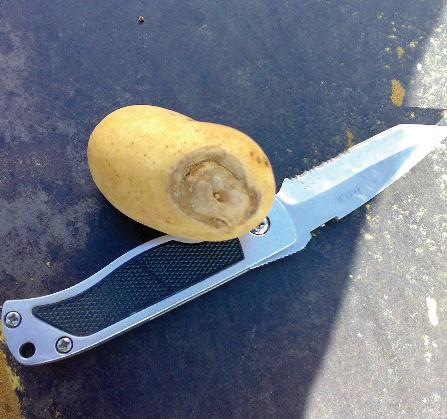
9 minute read
Awareness - potato spraing causing quarantine pests
Awareness – potato spraing causing quarantine pests with confusing symptoms
SPRAING IS THE TERM used for a range of internal and external symptoms occurring in the potato tuber flesh, consisting of brown, necrotic rings, arcs and flecks or spots (Photo 1) (Fera Spraing Disease of Potato, 2020). Two viruses which do not occur in South Africa can cause these symptoms, namely Tobacco Rattle Virus (TRV) and Potato Mop Top Virus (PMTV). Both these viruses are soil borne with similar symptoms but transmitted through different modes of transmission. These viruses are of economic importance due to the pre- sence of necrotic symptoms which may lead to downgrading or rejection of a seed lot and be unmarketable, especially if intended for processing.
Tobacco Rattle Virus (TRV)
Tobacco Rattle Virus (TRV) is transmitted by free living nema- todes, Trichodorus and Paratrichodorus spp., which are migratory root ectoparasites, also named stubby-root nematodes. When present in large populations, they may damage the potato, either directly by feeding on the root system thus causing necrosis or indirectly by transmission of TRV (Stent, 2011:115). In the presence of virus-carrying nematode popu- lations, susceptible cultivars to TRV may show symptoms. Adults and juveniles can transmit the virus when feeding on root cells and the virus can be retained for many months by non-feeding nematodes. Nematodes spread with surface water and favour light sandy soils, although TRV and its vector have been found in very diverse types of soil.
Symptoms on foliage
Certain plants can be healthy when infected seed potatoes are planted but in certain varieties the virus infection may cause mottled and/or distorted leaves. Different forms of mosaic symptoms and mottling, turning into necrotic spots (Photo 2) may be observed on leaves on one or two stems per plant which grows less vigorously. Progeny from infected plants are smaller and misshapen, with yield being affected (Wale et al., 2011:86).
Symptoms on tubers
In potatoes, TRV causes Corky Ringspot Disease (CRS), also known as Spraing. Symptom expression varies greatly and is affected by cultivar and environmental conditions (Wale et al., 2011:85). The most typical symptoms of TRV are usually found in the flesh of the tubers with brown necrotic arcs or corky spots sometimes extending over a large part of the tuber (Photo 3 and 4). Symptoms are not always visible on the tuber surface, but superficial necrosis (Photo 5) can sometimes be found, which can form rings around the lenticels (Photo 6) which, when cut, are not always related to internal necrosis and they remain localised, more or less discontinuous, underneath the skin (Photo 7). Symptoms do not increase during storage.
Photo 1: Spraing symptoms on TRV infected tubers. Source – Plant Management Network.

Photo 2: Potato leaf necrosis and chlorosis caused by TRV. Source Ephytia.
Potato Mop Top Virus (PMTV)
Potato Mop Top Virus (PMTV) is only known to be transmitted by the fungus Spongospora subterranea, the causal agent of powdery scab. PMTV is carried in the resting spores that can
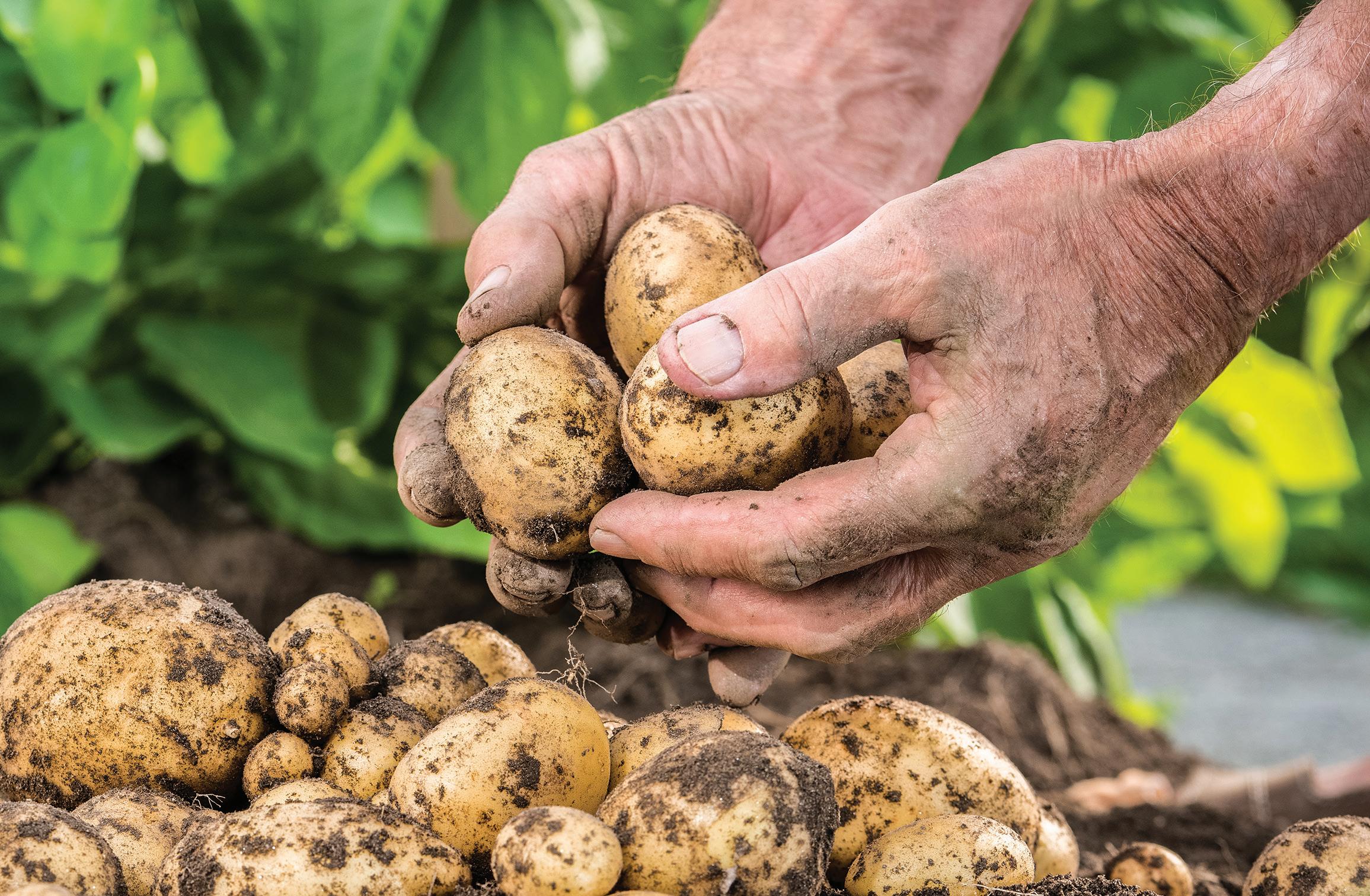
Aartappelprodukte wat werk
Die beproefde sukses van die Philagro produkreeks verseker dat ons produkte kop en skouers uitstaan in ‘n koste-doeltreffende aartappelprogram!
• Verbeter die uitloop van moere met ProGibb® 4% en ProGibb® 40 WG. Beheer: • Laatroes met Leimay® 200 SC – Nuwe eN uNieke chemie iN S.A. • Swartskurf en Stamkanker met Rizolex® WP • Afrika bolwurm, Aartappelmot en Tuta absoluta met SumiPleo® • Snywurms, Afrika bolwurm en Aartappelmot met Sumi-Alpha® 200 EC en Sumi-Alpha® 200 EW • Plusia landmeters met DiPel® DF en Florbac® WG • Vroëroes met Sumisclex® SC
Praat gerus met jou naaste Philagro-agent oor betroubare aartappelprodukte wat werk.
RAADPLEEG DIE ONDERSKEIE PRODUKETIKETTE VIR VOLLEDIGE GEBRUIKSAANWYSINGS & -BEPERKINGS.
DiPel® DF (Reg. nr. L6441, Wet nr. 36 van 1947) bevat Bacillus thuringiensis var kurstaki. Florbac® WG (Reg. nr. L5531, Wet nr. 36 van 1947) bevat Bacillus thuringiensis var aizawai. Leimay® 200 SC (Reg. nr. L10884, Wet nr. 36 van 1947) bevat Amisulbrom (sulfoamied), versigtig. ProGibb® 4% (Reg. nr. L5118, Wet nr. 36 van 1947) bevat gibberelliene, versigtig. ProGibb® 40WG (Reg. nr. L6777, Wet nr. 36 van 1947) bevat gibberelliene, versigtig. Rizolex® WP (Reg. nr. L6376, Wet nr. 36 van 1947) bevat tolklofosmetiel, versigtig. Sumi-Alpha® 200 EC (Reg. nr. L6452, Wet nr. 36 van 1947) bevat esfenvaleraat, giftig. SumiAlpha® 200 EW (Reg. nr. L8821, Wet nr. 36 van 1947) bevat esfenvaleraat, skadelik. Sumisclex® SC (Reg. nr. L6377, Wet nr. 36 van 1947) bevat prosimidoon. SumiPleo® (Reg. nr. L8377, Wet nr. 36 van 1947) bevat piradaliel dichloropropeen derivaat, versigtig. SumiPleo®, Rizolex®, Sumi-Alpha® en Sumisclex® is geregistreerde handelsmerke van Sumitomo Chemical Company, Japan. ProGibb®, DiPel® en Florbac® is geregistreerde handelsmerke van Valent BioSciences, VSA. Leimay® 200 SC is die geregistreerde handelsmerk van Nissan Chemical Industries LTD, Tokyo, Japan.
Philagro Suid-Afrika (Edms) Bpk l Reg. nr.: 98/10658107 PostNet Suite #378, Privaatsak X025, Lynnwoodrif 0040 Pretoria: 012 348 8808 l Somerset Wes: 021 851 4163
www.philagro.co.za
Awareness – potato spraing...
FROM PAGE 16

Photo 3: Internal necrosis on potato tuber caused by TRV. Source – Ephytia.
Photo 4: TRV Internal necrosis. Source – AHDB. Photo 5: External necrosis on potato tuber caused by TRV. Source Ephytia.
Photo 6: Necrosis around lenticels caused by TRV. Source – Wisconsin Department of Agriculture.
remain viable in soil for many years. Transmission is made possible by zoospores which have flagella that aid them to move in soil moisture (therefore favouring wet conditions) that can infect the roots or tubers. Transmission of the virus from an infected mother tuber to foliage is limited, and not all progeny tubers are infected. Affected tubers only transmit the viral disease to 20% to 50% of their progenies (Stent, 2011:48). PMTV will therefore self-eli- minate due to low rate of transmission of the virus within the plant from seed potato to progeny (UNECE Guide to Seed Potato Diseases, Pests and Defects, 2020). PMTV will be spread to the next planting in resting spores of Spongospora subterranea carrying the virus and present on potato tubers or contaminated soil. Movement of infected tubers or plants, soil, machinery or manure therefore increases the risk of spreading the disease.
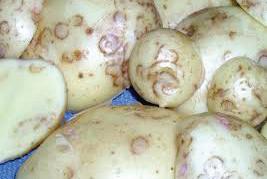
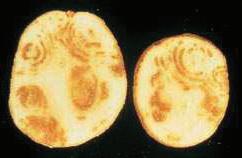
Photo 7 More or less discontinuous necrotic arcs and lines caused by TRV. Source – UNECE.

Photo 8: Bright yellow arcs or rings on the bottom leaves. Source – Ephytia.

Photo 9: V Shapes on the upper leaves caused by PMTV. Source – Ephytia. Symptoms on foliage
The initial or primary infection does not give rise to foliar symptoms but on plants developing from infected tubers, depending on the potato variety and environmental conditions, PMTV may cause several types of symptoms. The most common symptom is the yellow spots or patches in the form of arcs or chevrons on the lower leaves (Photo 8). Other symptoms include the shortening of the internodes of the upper leaves leading to a dwarfed bunched appearance (hence mop top) or yellow or pale green V shapes on upper leaflets (Photo 9), especially under cooler conditions. These symptoms are favoured by cool conditions.
Symptoms on tubers
As with the symptoms on foliage, depending on the potato variety and environmental conditions, symptoms caused by PMTV on tubers may vary greatly (Stent, 2011:49). During the season of infection, the tubers of susceptible varieties may develop internal brown necrotic arcs or spraing seen as brown rings on the tuber surface. Sudden or prolonged temperature drop, for example cold storage, can induce concentric rings or lines (Photo 10), which often extend into the flesh of the tuber, almost continuously, unlike TRV-symptoms. Tubers may also develop superficial raised rings without internal symptoms or develop no symptoms at all. Progeny tubers of infected PMTV material can be distorted cracked and russetted, with net like surface patches. (PMTV AHDB, 2020).
Confusing symptoms
PMTV or TRV can lead to the development of symptoms that may be confused with the following diseases or deviations: • Alfalfa Mosaic Virus (AMV) / Calico – Necrosis begins under the skin at the stolon end and extends to the entire tuber in the form of corky patches (Photo 11) similar to those induced by PMTV or TRV. • Internal Brown Spot – Small necrotic areas or brown spots of irregular shape and size occur in the internal area of the vascular ring (Photo 12) due to calcium deficiency which does not develop further in storage. Spraing caused PMTV and TRV can develop on the inside and outside of vascular ring. • Potato Leaf Roll Virus (PLRV) – Brown necrotic spots around the vascular ring (tuber net necrosis) caused by PLRV (Photo 13). • Potato Tuber Necrotic Ringspot Disease (PTNRD) – Thumb nail lesions (Photo 14) or brown blisters in the form
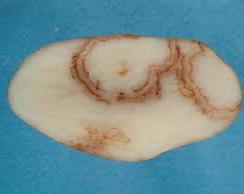
Photo 10: Continuous internal necrotic lines. Source – AHDB.

Photo 11: Internal symptoms caused by Calico - Source (Potato - Tobacco rattle virus (TRV), 2020).
TO PAGE 20
Awareness – potato spraing...
FROM PAGE 19
of arcs, rings or lines (thumb nail) which remain superficial with only slight penetration into the flesh. • Tomato Spotted Wilt Virus (TSWV) – TSWV can also induce external or internal concentric brown necrotic arcs, dark spots or internal necrosis and rot in the tuber flesh (Photo 15).
Diagnosis of spraing diseases is dependent upon symptom expression. Due to tuber symptoms being closely related, diag- nostic testing is recommended. Soil testing could also be done for the identification of Trichodorus and Paratrichodorus spp. In the United Kingdom, soil testing is done by allowing simultaneous detection of PMTV and TRV. Regulations limited the import of potato material to disease-free potato tissue culture material and mini tubers (G0 seed potatoes). The Potato Industry and the National Plant Protection Organization of South Africa (NPPOZA) work closely together to protect the potato industry from the introduction of new pests. However, potatoes are not the only pathway of introduction and therefore it is important to stay abreast with symptoms such as shown above to ensure early detected and eradication of such pests. Should suspicious symptoms are detected, contact Potato Certification Service to assist with identification and the way forward.
References
Ahdb.org.uk. 2020. Potato Mop Top Virus (PMTV) | AHDB. [online] Available at: <https://ahdb.org.uk/knowledge-library/ potato-mop-top-virus-pmtv> [Accessed 14 July 2020]. King, C., 2020. A Tuber-Damaging Strain of Alfalfa Mosaic Virus - Spud Smart. [online] Spud Smart. Available at: <https:// spudsmart.com/tuber-damaging-strain-alfalfa-mosaic-virus/> [Accessed 14 July 2020]. Mulder, A. & Turkensteen, L.J. 2005. Potato Diseases, Pests and Defects. Stent, T. 2011. A Practical Guide to Diseases, Pests and Disorders of The Potato. France: FN3PT, GNIS & ARVALIS. Wale, A, Platt, H.W. & Cattlin, N. 2011. Diseases, Pests and Disorders of Potatoes.
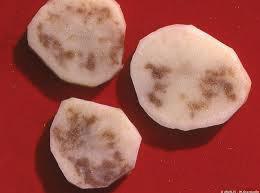
Photo 12: Internal Brown Spot. Source – Ephytia. Photo 13: Net necrosis caused by PLRV. Source – Ephytia.
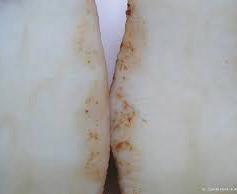
Photo 14: Thumb nail type necrotic rings caused by PTNRD. Source – PCS.
Photo 15: Internal TSWV-symptoms. Source – PCS.
